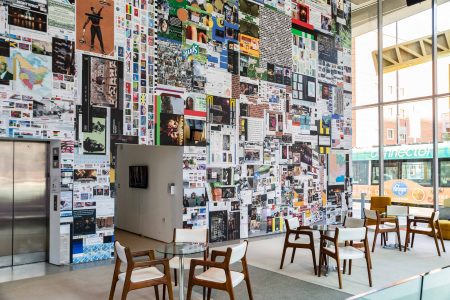Engaging with Kahlil Robert Irvings’s installation requires action. Its scale requires moving one’s body, viewing it first from afar and then up close. From a distance, such as viewed from outside standing on 6th street, it’s a frenetic tableau of screenshots. There are memes and browser tabs, overlapping digital prints filling the lobby’s central wall. They are right side up and upside down and sideways, simultaneously pushing forward and receding, like a face/vase optical illusion. A few larger images stand out: A blue sky; Serena Williams photographed mid-serve, upward stretched arm parallel to an upside down Sprite logo; elsewhere, an upside down waterfall. But these images mainly move the eye around the composition. It’s a familiar disorientation. It recalls 4am Facebook binges, when the screen and brain fuse in inter-ocular space (retina-to-retina). It recalls endless scrolling, when posts stop registering as anything in particular but pure content: bursts of dopamine as each rectangle slides to oblivion beyond the screen’s edge, the brain/screen event horizon. Content cascading like water.

Installation view: Kahlil Robert Irving: “Ground water from screen Falls [(Collaged media) + Midwest] STREET”, Contemporary Arts Center, Cincinnati, February 21-August 16, 2020. Photo: Tony March, 2020.
From this distance, the installation points to a different kind of scale and disorientation. It recalls another all-too-familiar experience, the 4am breaking news alert. Another Black life has been taken by police. Another Black life has been taken by police. Another Black life has been taken by police. Eventually the repetition becomes the defining quality. Another… another… another… At this point, it’s necessary to take a few steps back and see the patterns cascading like water.

Installation view: Kahlil Robert Irving: “Ground water from screen Falls [(Collaged media) + Midwest] STREET”, Contemporary Arts Center, Cincinnati, February 21-August 16, 2020. Photo: Tony March, 2020.
The effects of scale and disorientation as well as the use of sky, water, and pavement imagery in the composition are key elements to how it operates. “We’re always situated to the ground and dreaming of the sky above,” Irving said in a June 4th virtual presentation to the Portland State University MFA program. The installation’s title is a reference to TLC’s 1995 hit song “Waterfalls”, in which an inner-city Black family orients themselves between their desires and the material reality of their lives. This is seen throughout the composition, which not only juxtaposes images of pavement with “clear blue and unconditioned skies” but also seems to cascade like a waterfall, recalling aquatic metaphors for information (e.g. a “firehose”, a “flood”, etc.). Additionally, asking the viewer to navigate space is not only a re-rendering of this narrative, it hearkens to the near impossibility of not moving to TLC’s irresistible groove.

Installation view: Kahlil Robert Irving: “Ground water from screen Falls [(Collaged media) + Midwest] STREET”, Contemporary Arts Center, Cincinnati, February 21-August 16, 2020. Photo: Tony March, 2020.
![Kahlil Robert Irving “Ground Water From Screen Falls [(Collaged Media + Midwest STREET)]” (detail). Image courtesy of the Contemporary Arts Center.](http://aeqai.com/main/wp-content/uploads/2020/06/DSC8893-450x300.jpg)
Installation view: Kahlil Robert Irving: “Ground water from screen Falls [(Collaged media) + Midwest] STREET”, Contemporary Arts Center, Cincinnati, February 21-August 16, 2020. Photo: Tony March, 2020.
“Ground Water From Screen Falls [(Collaged Media + Midwest STREET)]” embodies this same play of presence and absence. Like his works in ceramics, it engages in multiple inversions through levels of re-representation. It points to the screenshot as a surface of relief — much in the same way that large volumes of metadata can generate surprisingly accurate behavioral models of an individual,[2] an accumulation of screenshots is an intimate relief portrait. The aesthetic experience of this negated negation places the viewer in a position to act. The viewer’s gaze becomes one of asserting the fullness of a negated form. What Irving accomplishes is to present a revolutionary aesthetic wherein the act of looking can be anti-racist and anti-colonialist. Rather than becoming mired in the fatalistic sameness of repetition, it invites the viewer to look in this way, thus opening up aesthetic space as liberating rather than as confining.
POSTSCRIPT — A major element of this work that I have not engaged with is its emphasis on the Midwest as a place. Irving, who grew up in Saint Louis, incorporates many references to Midwestern locations and events. (For example, its waterfall is a photograph captured at Krohn Conservatory). As the CAC reopens in July and viewers encounter this installation after having witnessed the Cincinnati Police Department’s brutal actions against demonstrators, I can only hope contemplating Irving’s intervention may widen the sense of aesthetic and political possibility by revealing parallels between the work’s revolutionary potential and the revolutionary actuality transpiring outside, thus fulfilling the intent of Hadid’s “Urban Carpet”.
Kahlil Robert Irving’s “Ground Water From Screen Falls [(Collaged Media + Midwest STREET)]” was organized by Senior Curator Amara Antilla and will be on view at the Contemporary Arts Center through August 16th, 2020. A second phase of the installation involving an Irving-designed carpet is scheduled for installation sometime in 2021.
—Steve Kemple
[1] In a 2017 interview with Strange Fire Collective’s Jess T. Dugan, Irving says: “Many people only think of color existing optically or through light, but I challenge those theories by the presence of colors that are intrinsic to items physically inhabiting space. For example, a black coat is not empty, non-existent, or a black hole; it is a full object. Since the color is intrinsic to its existence the thought around the color and how we physically live with the color needs to be adjusted. Blackness is not synonymous with darkness. Within colonialism demonizing the color Black and idealizing whiteness has added a great barrier within contemporary culture.”
[2] see Shoshana Zuboff’s The Age of Surveillance Capitalism. New York: Public Affairs, 2018.



